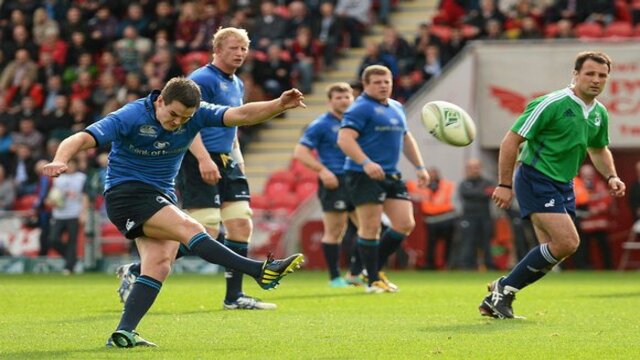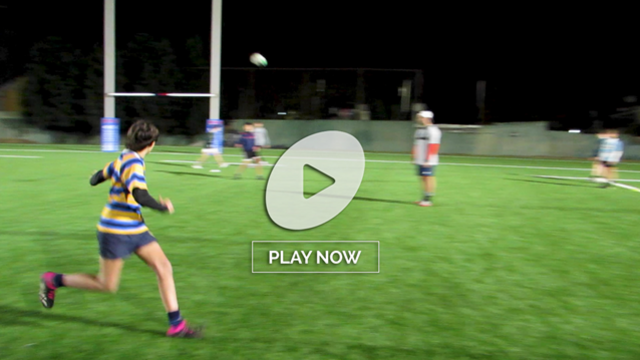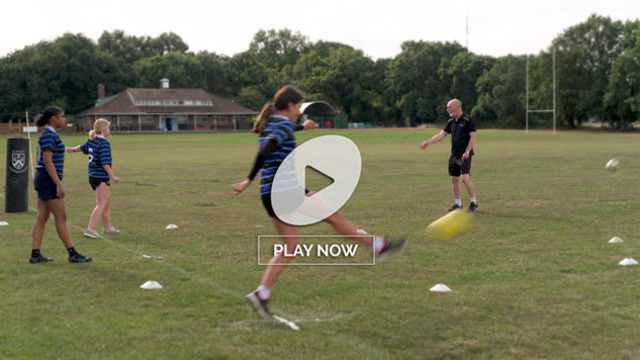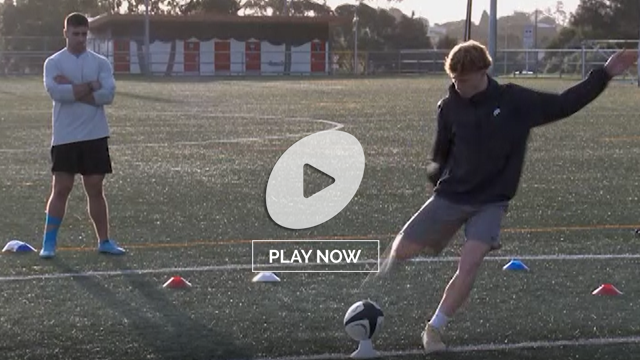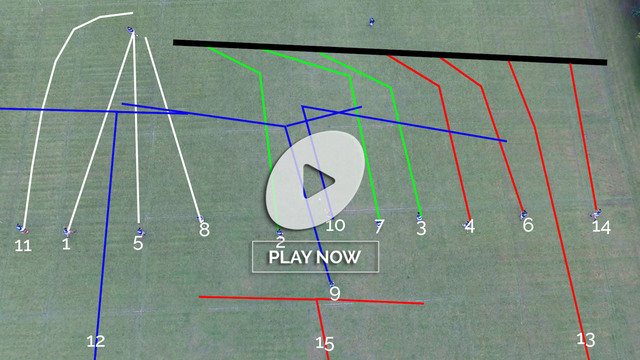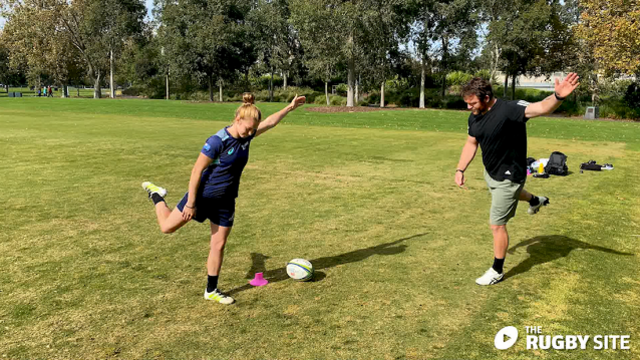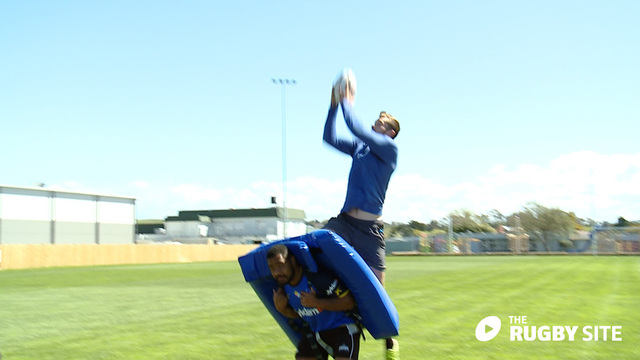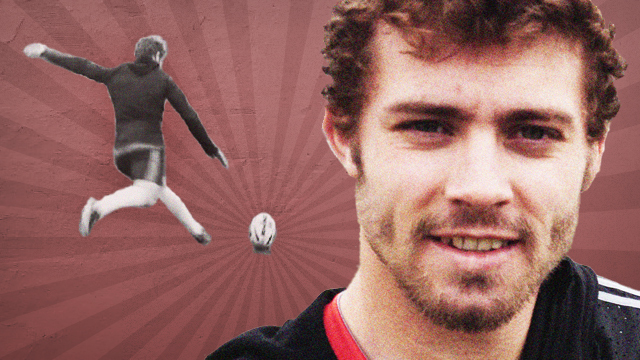Restarts are a heavily repeated feature of rugby games, but how much reward are teams getting from them?
The most common method of restarting [or kicking-off] is to send the ball long into the opposition 22, with the expectation that they will clear the ball into touch and the original restarting team will then have a set-piece platform to work off.
It makes perfect sense and it’s a low-risk strategy of restarting or kicking-off games. However, there are obviously instances where teams attempt to regain their restarts in the air, an option that is generally higher-risk but one that can also be high-reward.
Perhaps the most infamous recent example of a short restart attempt was Ireland’s against England in the 13-10 defeat at Twickenham during the Six Nations. With Joe Schmidt’s side 10-6 in front, Jonny Sexton attempted a short re-start wide to the left and the ball floated into touch.
While Ireland defended well initially off the subsequent scrum, England recovered to break the line and score through Danny Care. In this instance, the short restart clearly worked out badly for Ireland, although there were other mistakes involved in the English scoring.
“Against England, I was disappointed with one aspect of my game, that was my kick-offs,” admits Sexton. “I fluffed one; I was trying to kick it 11 metres and I kicked it eight.
“They’re small margins and it was the same with a couple of other short ones, I just got unlucky bounces or fluffed them. I gave them a scrum to put them in a good position. We put pressure back on them and they scored two phases later, but I’m sure it all came back to the kick-off.”
That Sexton should allude to small margins is of interest here, and his point is certainly a valid one. Dropping a short restart just over the opposition 10-metre line is an extremely demanding skill, regardless of whether a team goes to the left, centre or right.
While it is a team effort in regaining short restarts, Grenoble skills coach Mike Prendergast points out that the drop-kicking player [usually the out-half] is the key man.
“They’re difficult kicks to execute. I think a lot of it has to do with the execution of your 10. Some kicks suit certain out-halves and if you’re going to use the short restart, you need your 10s to upskill.”
Short drop-kicks appear to be even tougher when a right-footed out-half [or restarter] is kicking the ball wide to the left. Recent evidence suggest that most teams are struggling to get positive returns from these efforts to drop the ball just over the 10-metre line wide on the left.
Even Aaron Cruden of the Chiefs, who has worked incredibly hard to become effective with his short restarts, has encountered problems with this specific kick. We had another example in the Toulon v Toulouse clash last weekend, as Lionel Beauxis [another excellent drop-kicker] failed to send his kick the full 10 metres.

Even when the kick does hit the right zone of the pitch, defending teams are coping well with the short restart to their right. It appears that restarting teams are getting very little return from dropping their kicks into this area, even when the drop-off is good.
We saw an example of that in the Leinster v Munster encounter in Dublin last Saturday, when Ian Keatley’s kick was dropped by Gerhard van den Heever.

The kick itself needs to be inch-perfect for the kicking team to regain their restart, but the chasing player[s] have a vital role in ensuring that success too. Prendergast points to Schmidt’s Leinster as an example of a team who carried out short restarts effectively, highlighting the role of chasing players like Shane Horgan and Isa Nacewa.
Learn from Joe Schmidt and 19 other of the world’s leading coaches & players today
“With Leinster it worked very well. It’s about profiling the players, and having a tall winger or an athletic chaser helps. Obviously for kicks like that you need someone who’s quick over the ground and who can get up and make it contestable.”
Leinster have indeed enjoyed much success with short restarts to the left in recent years, but the higher percentage returns appear to have come from kick-offs to their right or to more central positions.
The eastern province did attempt one such kick against Munster last weekend, with Madigan dropping the restart at the beginning of the second half just over the 10-metre line and Rob Kearney [another excellent chaser] getting up in the air to compete.

The fullback ended up knocking the ball on and Munster were awarded the scrum, but Kearney was very close to regaining possession in the air. Ireland attempted exactly the same kick in Paris against France during the Six Nations, with Paul O’Connell making a sublime catch over his head to reclaim possession at 6-0 down.
Attempting short restarts into the middle of the pitch involves one of the most demanding drop-kicks in the game, according to Prendergast, who also points out the risks involved in kicking to that zone.
Should the defending team win the ball, their options from the centre of the pitch and near the halfway line are multiple.
“From an exit point of view on their part, they’ll have three kicking options there. But if you have the out-half to execute that skill and a very athletic chaser to bring in just behind the 10, it can work. Obviously winning it back there, you have both sides to play off in attack too.”
Last weekend, Perpignan provided a fine example of a short restart to the centre of the pitch working out to great effect during their clash with Bordeaux in the Top 14, having just gone 13-0 down.
Tommaso Allan got enough hang time on his restart to allow his chasers to apply real pressure on the defending players, and while there wasn’t a clean catch directly from the kick, Perpignan created enough chaos to pounce on the loose ball.
There are obviously lots of examples where short restarts into the centre of the pitch do not result in the kicking team regaining possession, but with the right elements involved, it can be a hugely effective tool.
Australia have perhaps the best fielder of kicks in world rugby in Israel Folau, but their reflectance to use him to retrieve restarts until they were significantly trailing games last year was notable. When they did use him under short drop-offs, they caused severe panic in the opposition ranks.
When considering whether or not short restarts are worth investing the time into practicing enough to make them effective, some teams may decide that the returns even if the kicks are regained are not worth that effort, leaving them 38 metres or so away from the defence’s tryline [whereas a line-out resulting from a long restart may be closer in].
Furthermore, one would have to presume that professional teams have the data to judge whether or not short restarts do actually result in the kicking team regaining possession very often.
What the statistics probably do not measure are the emotional benefits of regaining a short restart. Linebreaks, big hits and turnovers are all momentum boosts for rugby teams, but a reclaimed restart can have a similarly uplifting effect.
The short restart that we have seen work most often in recent years is a low trajectory kick just beyond the 10-metre line on the right. New Zealand have made something of an art form of this particular restart, with Dan Carter’s superb kicking often allowing Kieran Read to make a catch just over head height.
Watch Dan Carter’s video on Drop Kick Restarts
Leinster pulled off that exact kick against Munster last weekend, with Madigan hitting Fergus McFadden wide on the right immediately after Matt O’Connor’s team went 12-3 down in the first half.
It’s an area of the pitch that many teams leave unoccupied in defending restarts, as indicated in the shot below.

Without having access to data in this area, it is nigh on impossible to prove that short restarts to the right are more effective than others, but that is the impression this writer has built from watching games in various competitions [feel free to argue against that assertion, as others have!]
Short restarts are most commonly used when teams are some distance behind on the scoreboard, and therefore more willing to ‘risk’ them. However, New Zealand and Leinster have both shown in recent years that a well-rehearsed and well-planned short restart strategy can be effective.
Clearly kicking every restart in a game short is not a realistic option, but the sporadic and intelligent use of the tactic can lead to great rewards in terms of possession, emotional energy and even the odd try-scoring opportunity.
Following Ireland’s progress in this regard, after fleeting examples during the Six Nations, will be intriguing. In Sexton, the Kearney brothers, O’Connell, Peter O’Mahony and Tommy Bowe, they have the tools to build a highly functioning short restart unit.
What is your experience of short restarts? What impressions of the tactic and kicking technique have you built from watching and/or playing the game? Is the risk worth the reward? Or can effective planning and training of short restarts remove the risk involved? All thoughts are greatly welcome…
Murray Kinsella is a staff writer with TheScore.ie
